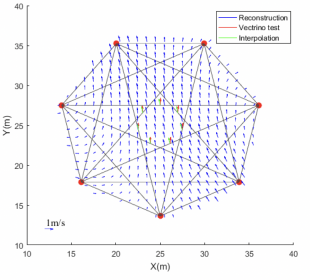ORCA Hub
ORCA Hub was a multi-dimensional project, funded by EPSRC, that aims to, through the use of robotic systems, sensor networks and artificial intelligence, create autonomous and semi-autonomous offshore energy stations. One of the great challenges in offshore energy is the extreme environment, this leads to both the need for regular repair of systems but also the difficulty in engineers gaining access to these systems. The ORCA Hub project aims to help combat this. ORCA Hub tested their ROVs and sensors at FloWave, aiming to improve how reliably autonomous systems can perform in harsh ocean environments.
Mapping water flow using acoustic tomography
One novel method for measuring water flow that has been developed at FloWave the use of acoustic underwater tomography to map the velocity field in the tank. This work was conducted by Dr Guaming Li and was based on the Coastal Acoustic Tomography system designed by Professor Arata Kaneko’s group at Hiroshima University.
Acoustic tomography works by sending sound pulses between two stations, synchronised using GPS clocks. The first station sends out a pulse. The receiving station not only hears this original pulse, but also the echoes reflected from the tank floor, wave makers and the water surface. The process is then reversed and the second station sends out a pulse while the first station listens. Using ray tracing one can then find the distance travelled by these pulses. Comparing the arrival times of the signals in both directions allows the average velocity along each ray to be estimated. We use these estimates to form an approximation of the stream function, and so have a map of the velocity between the two stations. The resulting velocity map was compared with point measurements taken using our Vectrino acoustic Doppler current meter with good agreement across FloWave’s central test area.
Full details of the experiments and the method can be found in Dr Guanming Li's PhD Thesis





